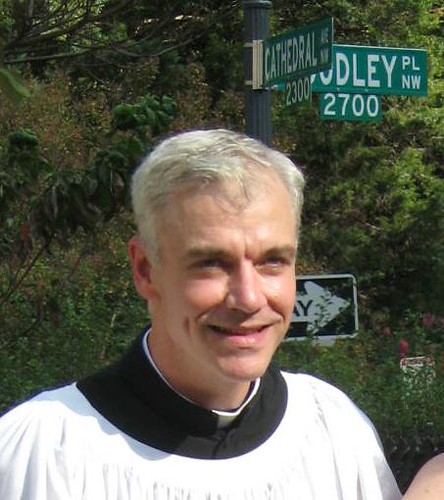An Ascended View of Things

A sermon for the Seventh Sunday of Easter, June 5, 2011. The lectionary readings are Acts 1:6-14 , Psalm 68:1-10, 33-36, 1 Peter 4:12-14, 5:6-11, and John 17:1-11 .
In this morning’s first reading we hear about the Ascension of Jesus. Always observed 40 days after Easter, Ascension was celebrated at All Souls and in Christian churches throughout the world on Thursday morning.
Jesus has ascended into heaven.
We say this each time we repeat the Nicene Creed.
And we hear about the Ascension again from this morning’s first reading. We hear how Jesus was taken from his disciples, taken up in the mystery of a cloud, and he left them.
He was lifted up. He was raised up, he was exalted. Not only is this an extension of his being lifted up on the cross for our sake, but really, it’s an image that explains the way Jesus sees others through the Gospels. And it’s a way that describes how Jesus enables US to see others.
His whole life, Jesus seems to view people from another perspective, from the perspective of his father in heaven. Though Jesus is among people—he walks the streets, the breathes the same dust, he eats the same food, in a hug or an embrace he the touches and holds the same human flesh; he never loses that ability to SEE from another point of view.
Throughout, he seems to operate from a different height. He sees things others don’t see. And he does not spend much time looking close-up at some of the things that the religious leaders of his day took great pains to stare at, dwell upon and magnify.
Jesus looked at people differently. When Zaccheus the tax collector approached Jesus, the other people saw Zaccheus as a horrible little man, a cheat, a swindler, and a sell-out to the Romans. But Jesus saw Zaccheus as a child of God. Jesus made no excuses for Zaccheus, but he called him to a new way of life.
The woman accused of adultery was seen by the crowd as no good, beyond being helped, with no self-respect and no sense of morality. But Jesus saw her differently, he saw her not by romanticizing her victimhood, but by calling out of her the very best that she could become.
With almost everyone he encounters, Jesus sees with God’s eyes, as though from a higher place. All the while, Jesus remains rooted, feet firmly on the ground, noticing even the lowly and the earthbound.
Through his life, death, resurrection and ascension, Jesus has opened for us the way to heaven. With his Spirit in us, we, with the Grace of God, we too can catch a glimpse of his perspective.
This morning, we baptize Michael Wadsworth, just like we baptized William two years ago. As we celebrate his baptism, remember, and give thanks for our own baptisms, we can reflect on how the baptismal water buoys us up. It lifts us up out of sin and death, and helps us to stand and run, and LIVE. Through baptism we are sealed with the knowledge that we are more than what we may appear. We are more than how we look, or how we talk, or what we know, or how we perform, or how much money we make, or how many friends we have, or what a good spouse or parent or child we are. We are lifted up above all of that by the love of Christ and we can view ourselves, even, from an ascended place; from a higher place.
What would it be like if we lived day to day, with the ability to see other people not in their failures and shortcomings, but in their potential? What would it be like for us to see ourselves, not the way we felt in elementary school, but as God sees us, not denying our faults, but seeing them in the context of our potential as children of God, capable of love that changes the world?
Austin Farrer, an English theologian who died in the 1960’s, writes of the ascension of Jesus by first reminding us of another ascension into heaven, the ascension of Elijah the prophet. It was Elijah who was thought to have ascended into heaven on the crests of flaming horses, horses on fire.
But with Jesus, the flame that carried him into heaven is what Farrer calls the “flame of Christ’s own sacrifice.” Look at the flame of a candle, he says, the flame always is drawn upward.
“All his life long Christ’s love burnt towards the heart of heaven in a bright fire, until he was wholly consumed in it, and went up in that fire to God. The fire is kindled on our altars, here Christ ascends in fire; the fire is kindled in the Christian heart, and we ascend. He says to us, Lift up your hearts; and we reply, We lift them up unto the Lord.” [The Crown of the Year, p. 34.]
In Holy Baptism we bless water with the Pascal Candle, a candle whose light begins at the Easter Vigil, with the first promise of resurrection. We give the baptized person a special candle—a candle that might be lit every year on the anniversary of his baptism, if he wants—and with that light, we say, “You have been enlightened by Christ. Walk always as a child of the light and keep the flame of faith alive in your heart.”
As we lift our hearts to God, it is especially appropriate that we claim for ourselves the full power of the Ascension. We can ask God to lift us up higher, to give us a new perspective on one another, to see ourselves more like God sees us, and finally, to be lifted into the very presence of God, Father, Son and Holy Ghost.


No comments:
Post a Comment